Transformational Leadership: Nursing Practice and Patient Outcomes
VerifiedAdded on 2022/08/31
|9
|2572
|13
Essay
AI Summary
This essay delves into the concept of transformational leadership and its application within the nursing profession, emphasizing its role in enhancing efficiency and patient outcomes in clinical settings. The essay begins by defining transformational leadership, tracing its origins and outlining its core principles, including idealized influence, inspirational motivation, intellectual stimulation, and individualized consideration. It then explores how this leadership style can be effectively implemented across various nursing roles, such as bedside nurses, public health nurses, and Chief Nursing Officers (CNOs), highlighting the unique responsibilities and challenges faced by each. The author discusses how transformational leadership fosters improved communication, teamwork, and a supportive work environment, ultimately leading to better patient care and reduced resource waste. The essay further reflects on the author's personal experience with transformational leadership, discussing their strengths, weaknesses, and areas for improvement. Finally, it identifies key traits of a successful nurse leader, emphasizing the importance of experience, strong interpersonal relationships, and the ability to incorporate diverse perspectives. The essay concludes by reiterating the significance of transformational leadership in the demanding and evolving field of nursing, advocating for its continued adoption to cultivate future nursing leaders and improve patient welfare.
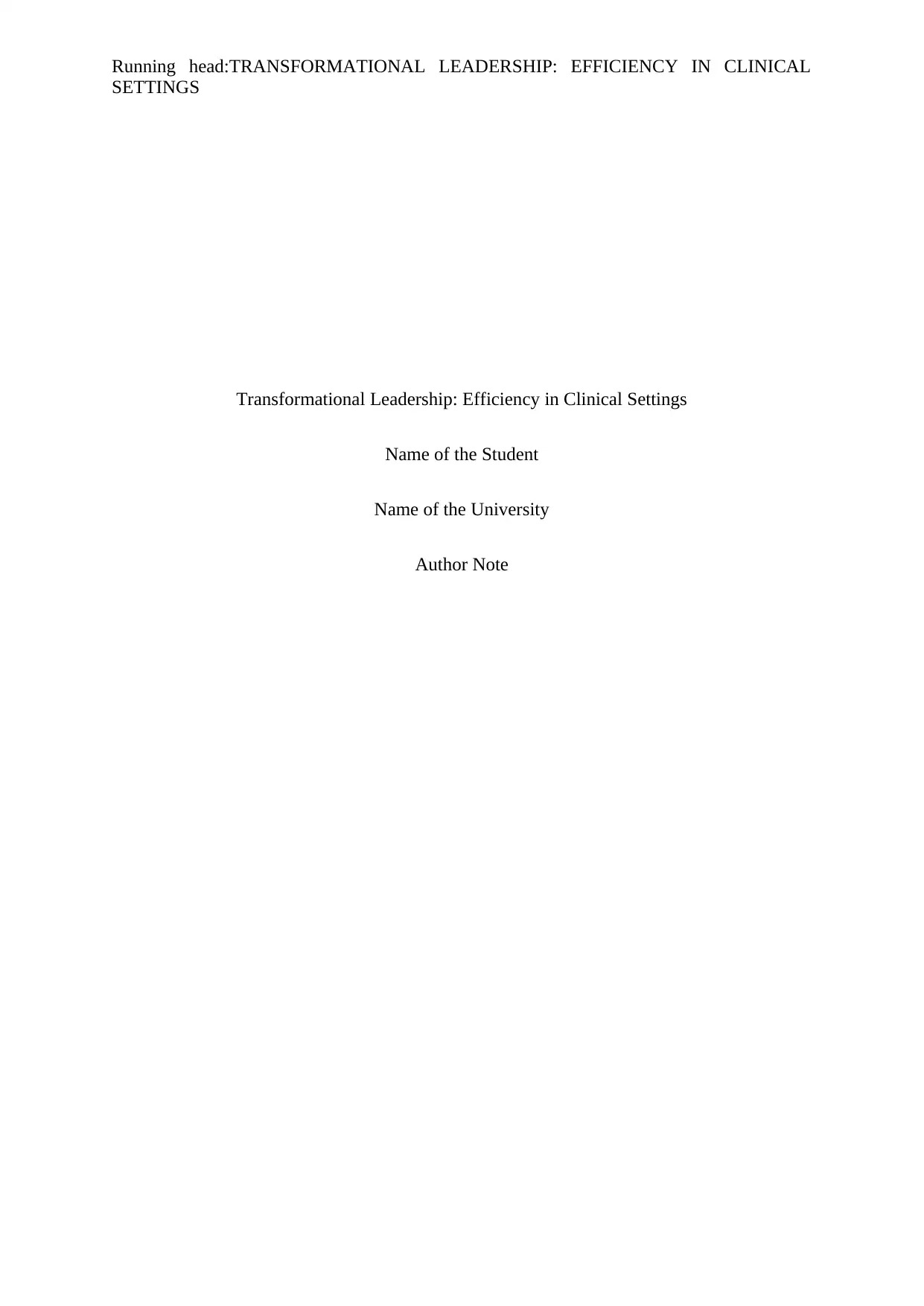
Running head:TRANSFORMATIONAL LEADERSHIP: EFFICIENCY IN CLINICAL
SETTINGS
Transformational Leadership: Efficiency in Clinical Settings
Name of the Student
Name of the University
Author Note
SETTINGS
Transformational Leadership: Efficiency in Clinical Settings
Name of the Student
Name of the University
Author Note
Paraphrase This Document
Need a fresh take? Get an instant paraphrase of this document with our AI Paraphraser
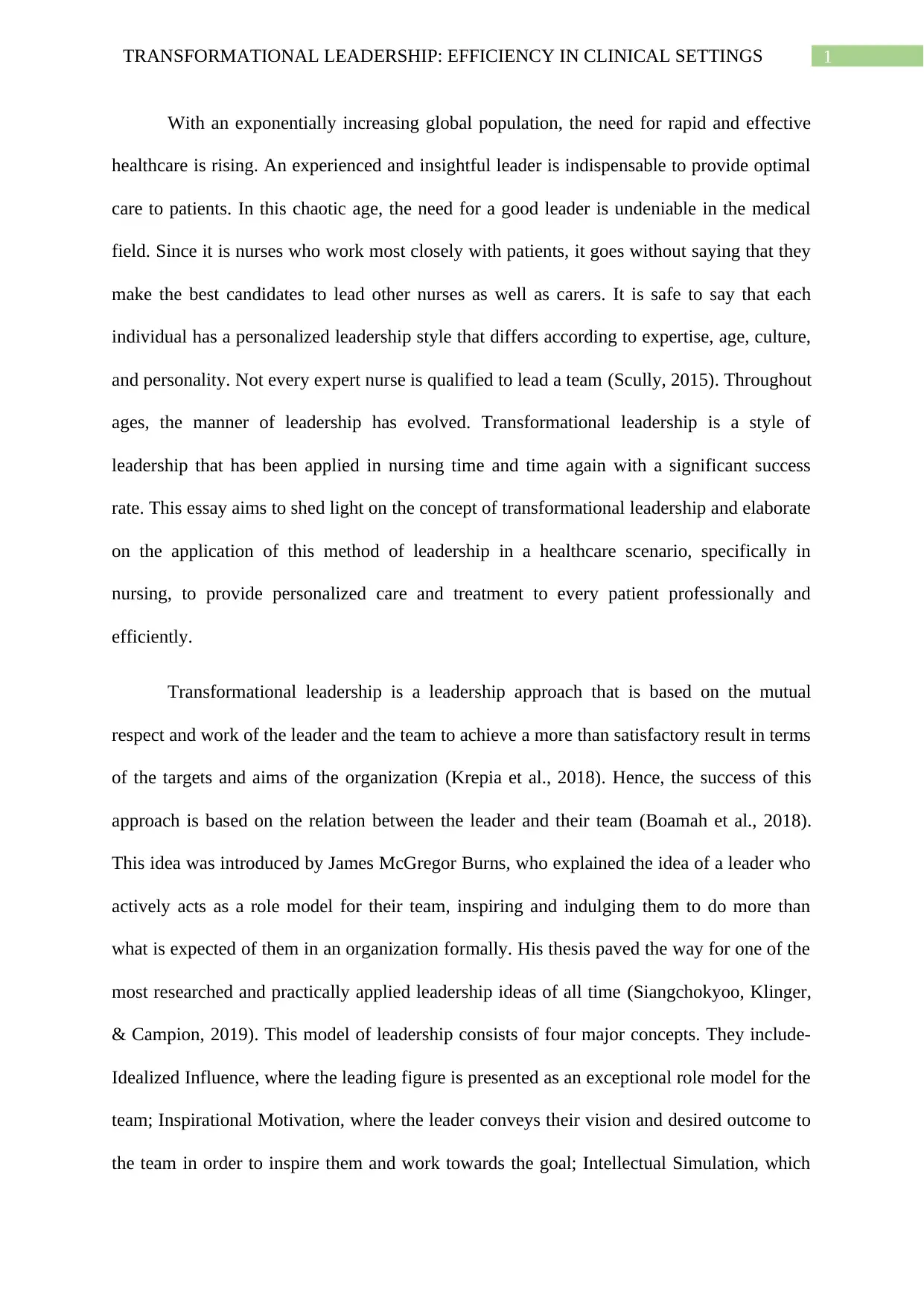
1TRANSFORMATIONAL LEADERSHIP: EFFICIENCY IN CLINICAL SETTINGS
With an exponentially increasing global population, the need for rapid and effective
healthcare is rising. An experienced and insightful leader is indispensable to provide optimal
care to patients. In this chaotic age, the need for a good leader is undeniable in the medical
field. Since it is nurses who work most closely with patients, it goes without saying that they
make the best candidates to lead other nurses as well as carers. It is safe to say that each
individual has a personalized leadership style that differs according to expertise, age, culture,
and personality. Not every expert nurse is qualified to lead a team (Scully, 2015). Throughout
ages, the manner of leadership has evolved. Transformational leadership is a style of
leadership that has been applied in nursing time and time again with a significant success
rate. This essay aims to shed light on the concept of transformational leadership and elaborate
on the application of this method of leadership in a healthcare scenario, specifically in
nursing, to provide personalized care and treatment to every patient professionally and
efficiently.
Transformational leadership is a leadership approach that is based on the mutual
respect and work of the leader and the team to achieve a more than satisfactory result in terms
of the targets and aims of the organization (Krepia et al., 2018). Hence, the success of this
approach is based on the relation between the leader and their team (Boamah et al., 2018).
This idea was introduced by James McGregor Burns, who explained the idea of a leader who
actively acts as a role model for their team, inspiring and indulging them to do more than
what is expected of them in an organization formally. His thesis paved the way for one of the
most researched and practically applied leadership ideas of all time (Siangchokyoo, Klinger,
& Campion, 2019). This model of leadership consists of four major concepts. They include-
Idealized Influence, where the leading figure is presented as an exceptional role model for the
team; Inspirational Motivation, where the leader conveys their vision and desired outcome to
the team in order to inspire them and work towards the goal; Intellectual Simulation, which
With an exponentially increasing global population, the need for rapid and effective
healthcare is rising. An experienced and insightful leader is indispensable to provide optimal
care to patients. In this chaotic age, the need for a good leader is undeniable in the medical
field. Since it is nurses who work most closely with patients, it goes without saying that they
make the best candidates to lead other nurses as well as carers. It is safe to say that each
individual has a personalized leadership style that differs according to expertise, age, culture,
and personality. Not every expert nurse is qualified to lead a team (Scully, 2015). Throughout
ages, the manner of leadership has evolved. Transformational leadership is a style of
leadership that has been applied in nursing time and time again with a significant success
rate. This essay aims to shed light on the concept of transformational leadership and elaborate
on the application of this method of leadership in a healthcare scenario, specifically in
nursing, to provide personalized care and treatment to every patient professionally and
efficiently.
Transformational leadership is a leadership approach that is based on the mutual
respect and work of the leader and the team to achieve a more than satisfactory result in terms
of the targets and aims of the organization (Krepia et al., 2018). Hence, the success of this
approach is based on the relation between the leader and their team (Boamah et al., 2018).
This idea was introduced by James McGregor Burns, who explained the idea of a leader who
actively acts as a role model for their team, inspiring and indulging them to do more than
what is expected of them in an organization formally. His thesis paved the way for one of the
most researched and practically applied leadership ideas of all time (Siangchokyoo, Klinger,
& Campion, 2019). This model of leadership consists of four major concepts. They include-
Idealized Influence, where the leading figure is presented as an exceptional role model for the
team; Inspirational Motivation, where the leader conveys their vision and desired outcome to
the team in order to inspire them and work towards the goal; Intellectual Simulation, which
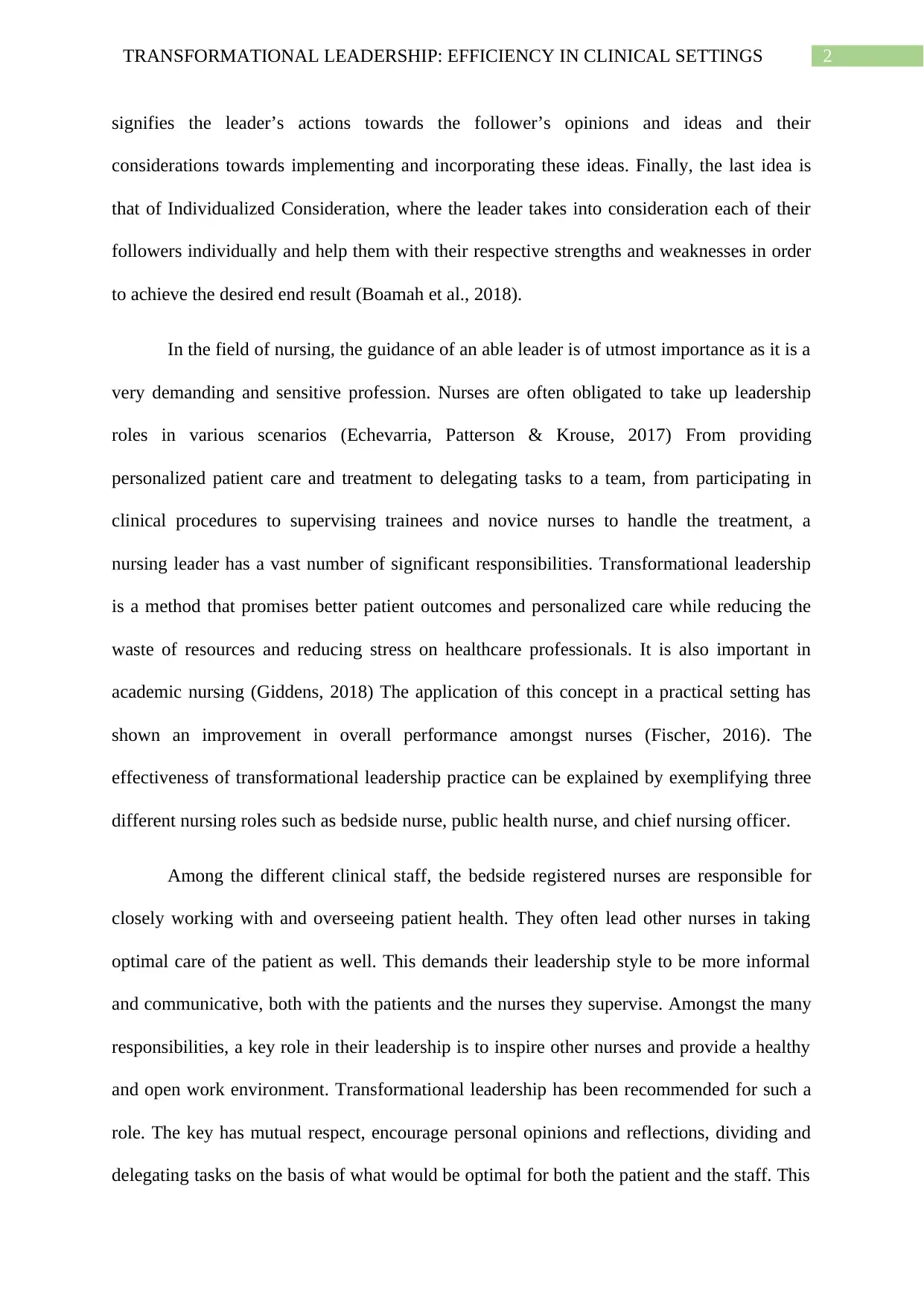
2TRANSFORMATIONAL LEADERSHIP: EFFICIENCY IN CLINICAL SETTINGS
signifies the leader’s actions towards the follower’s opinions and ideas and their
considerations towards implementing and incorporating these ideas. Finally, the last idea is
that of Individualized Consideration, where the leader takes into consideration each of their
followers individually and help them with their respective strengths and weaknesses in order
to achieve the desired end result (Boamah et al., 2018).
In the field of nursing, the guidance of an able leader is of utmost importance as it is a
very demanding and sensitive profession. Nurses are often obligated to take up leadership
roles in various scenarios (Echevarria, Patterson & Krouse, 2017) From providing
personalized patient care and treatment to delegating tasks to a team, from participating in
clinical procedures to supervising trainees and novice nurses to handle the treatment, a
nursing leader has a vast number of significant responsibilities. Transformational leadership
is a method that promises better patient outcomes and personalized care while reducing the
waste of resources and reducing stress on healthcare professionals. It is also important in
academic nursing (Giddens, 2018) The application of this concept in a practical setting has
shown an improvement in overall performance amongst nurses (Fischer, 2016). The
effectiveness of transformational leadership practice can be explained by exemplifying three
different nursing roles such as bedside nurse, public health nurse, and chief nursing officer.
Among the different clinical staff, the bedside registered nurses are responsible for
closely working with and overseeing patient health. They often lead other nurses in taking
optimal care of the patient as well. This demands their leadership style to be more informal
and communicative, both with the patients and the nurses they supervise. Amongst the many
responsibilities, a key role in their leadership is to inspire other nurses and provide a healthy
and open work environment. Transformational leadership has been recommended for such a
role. The key has mutual respect, encourage personal opinions and reflections, dividing and
delegating tasks on the basis of what would be optimal for both the patient and the staff. This
signifies the leader’s actions towards the follower’s opinions and ideas and their
considerations towards implementing and incorporating these ideas. Finally, the last idea is
that of Individualized Consideration, where the leader takes into consideration each of their
followers individually and help them with their respective strengths and weaknesses in order
to achieve the desired end result (Boamah et al., 2018).
In the field of nursing, the guidance of an able leader is of utmost importance as it is a
very demanding and sensitive profession. Nurses are often obligated to take up leadership
roles in various scenarios (Echevarria, Patterson & Krouse, 2017) From providing
personalized patient care and treatment to delegating tasks to a team, from participating in
clinical procedures to supervising trainees and novice nurses to handle the treatment, a
nursing leader has a vast number of significant responsibilities. Transformational leadership
is a method that promises better patient outcomes and personalized care while reducing the
waste of resources and reducing stress on healthcare professionals. It is also important in
academic nursing (Giddens, 2018) The application of this concept in a practical setting has
shown an improvement in overall performance amongst nurses (Fischer, 2016). The
effectiveness of transformational leadership practice can be explained by exemplifying three
different nursing roles such as bedside nurse, public health nurse, and chief nursing officer.
Among the different clinical staff, the bedside registered nurses are responsible for
closely working with and overseeing patient health. They often lead other nurses in taking
optimal care of the patient as well. This demands their leadership style to be more informal
and communicative, both with the patients and the nurses they supervise. Amongst the many
responsibilities, a key role in their leadership is to inspire other nurses and provide a healthy
and open work environment. Transformational leadership has been recommended for such a
role. The key has mutual respect, encourage personal opinions and reflections, dividing and
delegating tasks on the basis of what would be optimal for both the patient and the staff. This
⊘ This is a preview!⊘
Do you want full access?
Subscribe today to unlock all pages.

Trusted by 1+ million students worldwide
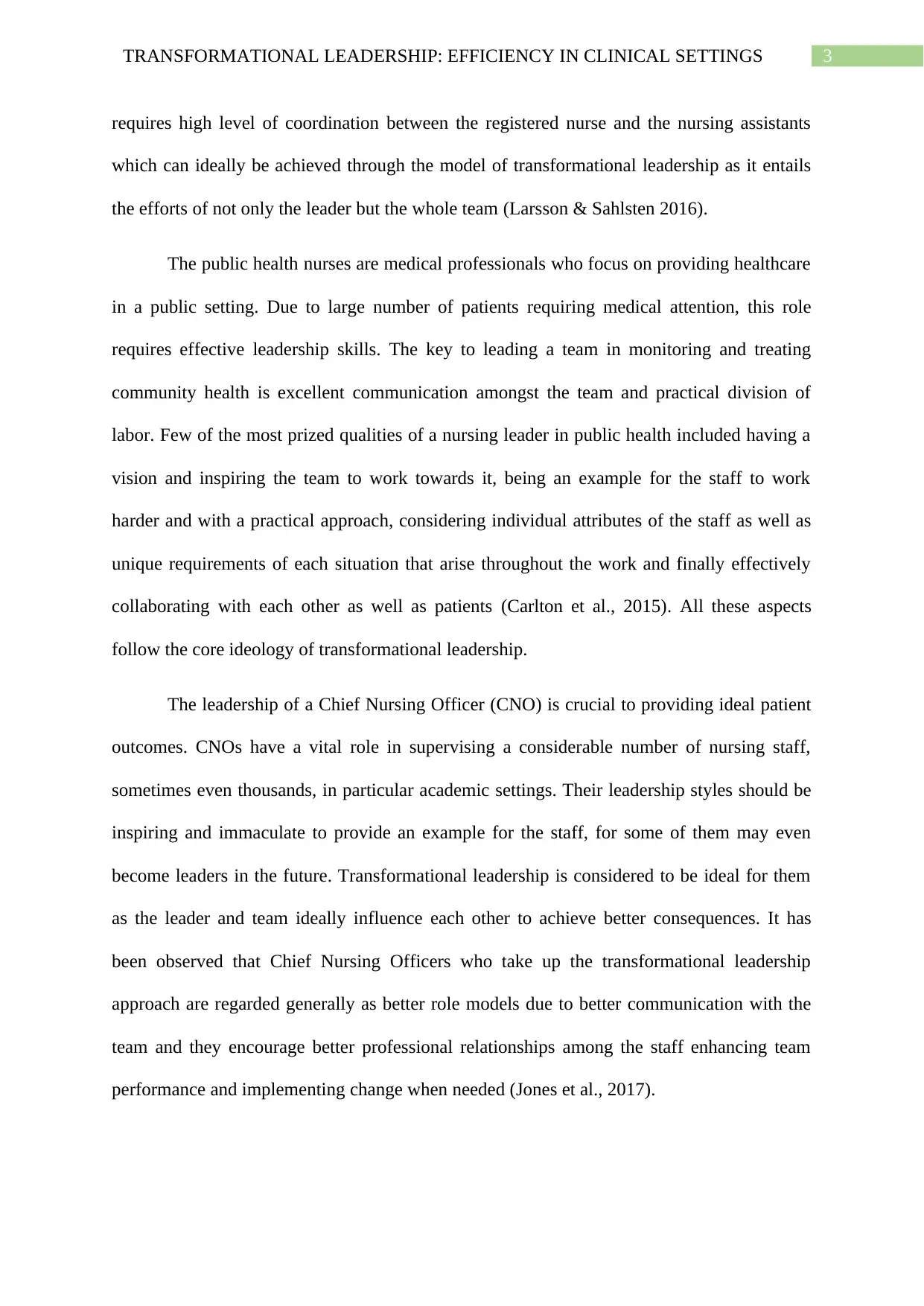
3TRANSFORMATIONAL LEADERSHIP: EFFICIENCY IN CLINICAL SETTINGS
requires high level of coordination between the registered nurse and the nursing assistants
which can ideally be achieved through the model of transformational leadership as it entails
the efforts of not only the leader but the whole team (Larsson & Sahlsten 2016).
The public health nurses are medical professionals who focus on providing healthcare
in a public setting. Due to large number of patients requiring medical attention, this role
requires effective leadership skills. The key to leading a team in monitoring and treating
community health is excellent communication amongst the team and practical division of
labor. Few of the most prized qualities of a nursing leader in public health included having a
vision and inspiring the team to work towards it, being an example for the staff to work
harder and with a practical approach, considering individual attributes of the staff as well as
unique requirements of each situation that arise throughout the work and finally effectively
collaborating with each other as well as patients (Carlton et al., 2015). All these aspects
follow the core ideology of transformational leadership.
The leadership of a Chief Nursing Officer (CNO) is crucial to providing ideal patient
outcomes. CNOs have a vital role in supervising a considerable number of nursing staff,
sometimes even thousands, in particular academic settings. Their leadership styles should be
inspiring and immaculate to provide an example for the staff, for some of them may even
become leaders in the future. Transformational leadership is considered to be ideal for them
as the leader and team ideally influence each other to achieve better consequences. It has
been observed that Chief Nursing Officers who take up the transformational leadership
approach are regarded generally as better role models due to better communication with the
team and they encourage better professional relationships among the staff enhancing team
performance and implementing change when needed (Jones et al., 2017).
requires high level of coordination between the registered nurse and the nursing assistants
which can ideally be achieved through the model of transformational leadership as it entails
the efforts of not only the leader but the whole team (Larsson & Sahlsten 2016).
The public health nurses are medical professionals who focus on providing healthcare
in a public setting. Due to large number of patients requiring medical attention, this role
requires effective leadership skills. The key to leading a team in monitoring and treating
community health is excellent communication amongst the team and practical division of
labor. Few of the most prized qualities of a nursing leader in public health included having a
vision and inspiring the team to work towards it, being an example for the staff to work
harder and with a practical approach, considering individual attributes of the staff as well as
unique requirements of each situation that arise throughout the work and finally effectively
collaborating with each other as well as patients (Carlton et al., 2015). All these aspects
follow the core ideology of transformational leadership.
The leadership of a Chief Nursing Officer (CNO) is crucial to providing ideal patient
outcomes. CNOs have a vital role in supervising a considerable number of nursing staff,
sometimes even thousands, in particular academic settings. Their leadership styles should be
inspiring and immaculate to provide an example for the staff, for some of them may even
become leaders in the future. Transformational leadership is considered to be ideal for them
as the leader and team ideally influence each other to achieve better consequences. It has
been observed that Chief Nursing Officers who take up the transformational leadership
approach are regarded generally as better role models due to better communication with the
team and they encourage better professional relationships among the staff enhancing team
performance and implementing change when needed (Jones et al., 2017).
Paraphrase This Document
Need a fresh take? Get an instant paraphrase of this document with our AI Paraphraser
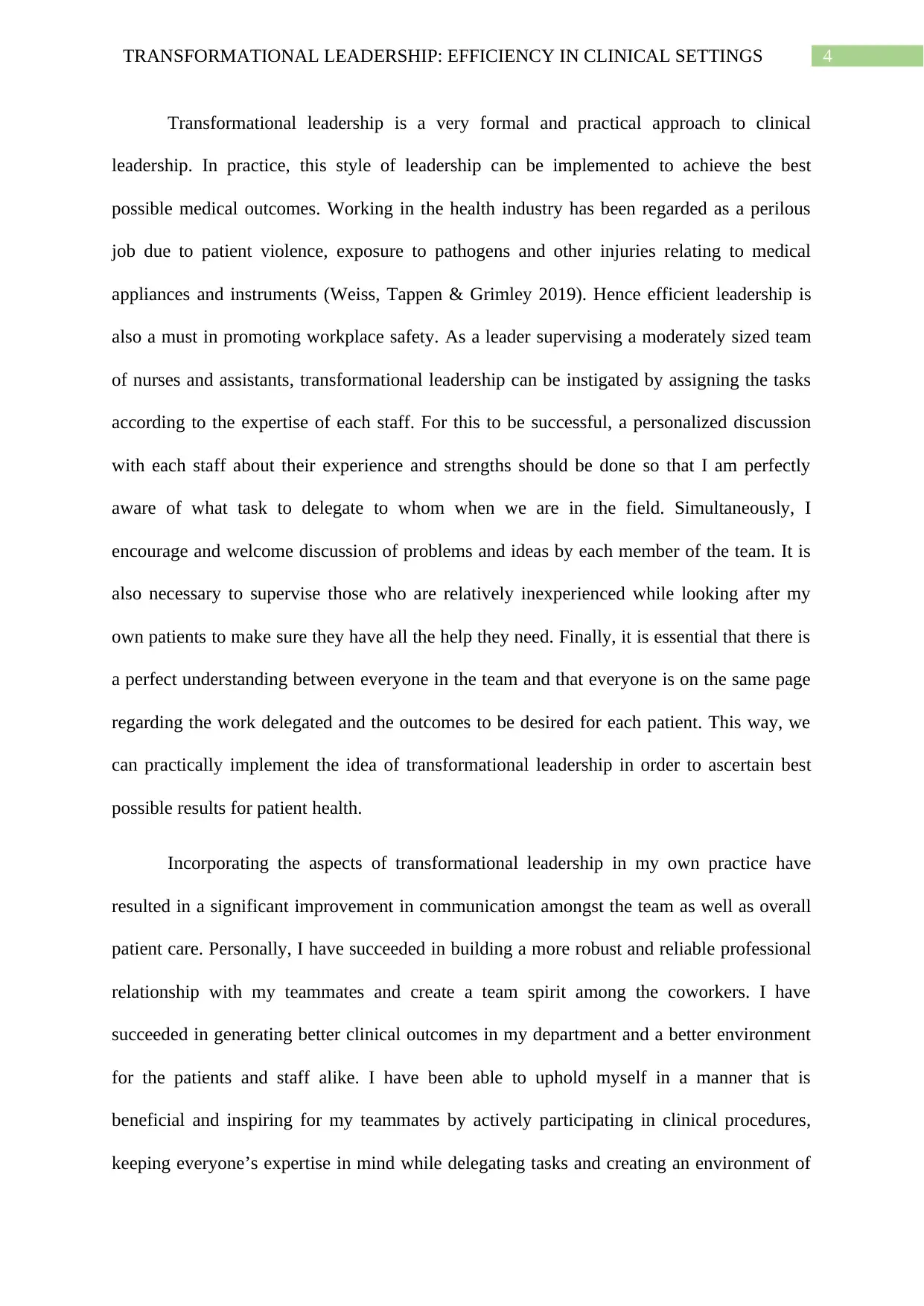
4TRANSFORMATIONAL LEADERSHIP: EFFICIENCY IN CLINICAL SETTINGS
Transformational leadership is a very formal and practical approach to clinical
leadership. In practice, this style of leadership can be implemented to achieve the best
possible medical outcomes. Working in the health industry has been regarded as a perilous
job due to patient violence, exposure to pathogens and other injuries relating to medical
appliances and instruments (Weiss, Tappen & Grimley 2019). Hence efficient leadership is
also a must in promoting workplace safety. As a leader supervising a moderately sized team
of nurses and assistants, transformational leadership can be instigated by assigning the tasks
according to the expertise of each staff. For this to be successful, a personalized discussion
with each staff about their experience and strengths should be done so that I am perfectly
aware of what task to delegate to whom when we are in the field. Simultaneously, I
encourage and welcome discussion of problems and ideas by each member of the team. It is
also necessary to supervise those who are relatively inexperienced while looking after my
own patients to make sure they have all the help they need. Finally, it is essential that there is
a perfect understanding between everyone in the team and that everyone is on the same page
regarding the work delegated and the outcomes to be desired for each patient. This way, we
can practically implement the idea of transformational leadership in order to ascertain best
possible results for patient health.
Incorporating the aspects of transformational leadership in my own practice have
resulted in a significant improvement in communication amongst the team as well as overall
patient care. Personally, I have succeeded in building a more robust and reliable professional
relationship with my teammates and create a team spirit among the coworkers. I have
succeeded in generating better clinical outcomes in my department and a better environment
for the patients and staff alike. I have been able to uphold myself in a manner that is
beneficial and inspiring for my teammates by actively participating in clinical procedures,
keeping everyone’s expertise in mind while delegating tasks and creating an environment of
Transformational leadership is a very formal and practical approach to clinical
leadership. In practice, this style of leadership can be implemented to achieve the best
possible medical outcomes. Working in the health industry has been regarded as a perilous
job due to patient violence, exposure to pathogens and other injuries relating to medical
appliances and instruments (Weiss, Tappen & Grimley 2019). Hence efficient leadership is
also a must in promoting workplace safety. As a leader supervising a moderately sized team
of nurses and assistants, transformational leadership can be instigated by assigning the tasks
according to the expertise of each staff. For this to be successful, a personalized discussion
with each staff about their experience and strengths should be done so that I am perfectly
aware of what task to delegate to whom when we are in the field. Simultaneously, I
encourage and welcome discussion of problems and ideas by each member of the team. It is
also necessary to supervise those who are relatively inexperienced while looking after my
own patients to make sure they have all the help they need. Finally, it is essential that there is
a perfect understanding between everyone in the team and that everyone is on the same page
regarding the work delegated and the outcomes to be desired for each patient. This way, we
can practically implement the idea of transformational leadership in order to ascertain best
possible results for patient health.
Incorporating the aspects of transformational leadership in my own practice have
resulted in a significant improvement in communication amongst the team as well as overall
patient care. Personally, I have succeeded in building a more robust and reliable professional
relationship with my teammates and create a team spirit among the coworkers. I have
succeeded in generating better clinical outcomes in my department and a better environment
for the patients and staff alike. I have been able to uphold myself in a manner that is
beneficial and inspiring for my teammates by actively participating in clinical procedures,
keeping everyone’s expertise in mind while delegating tasks and creating an environment of
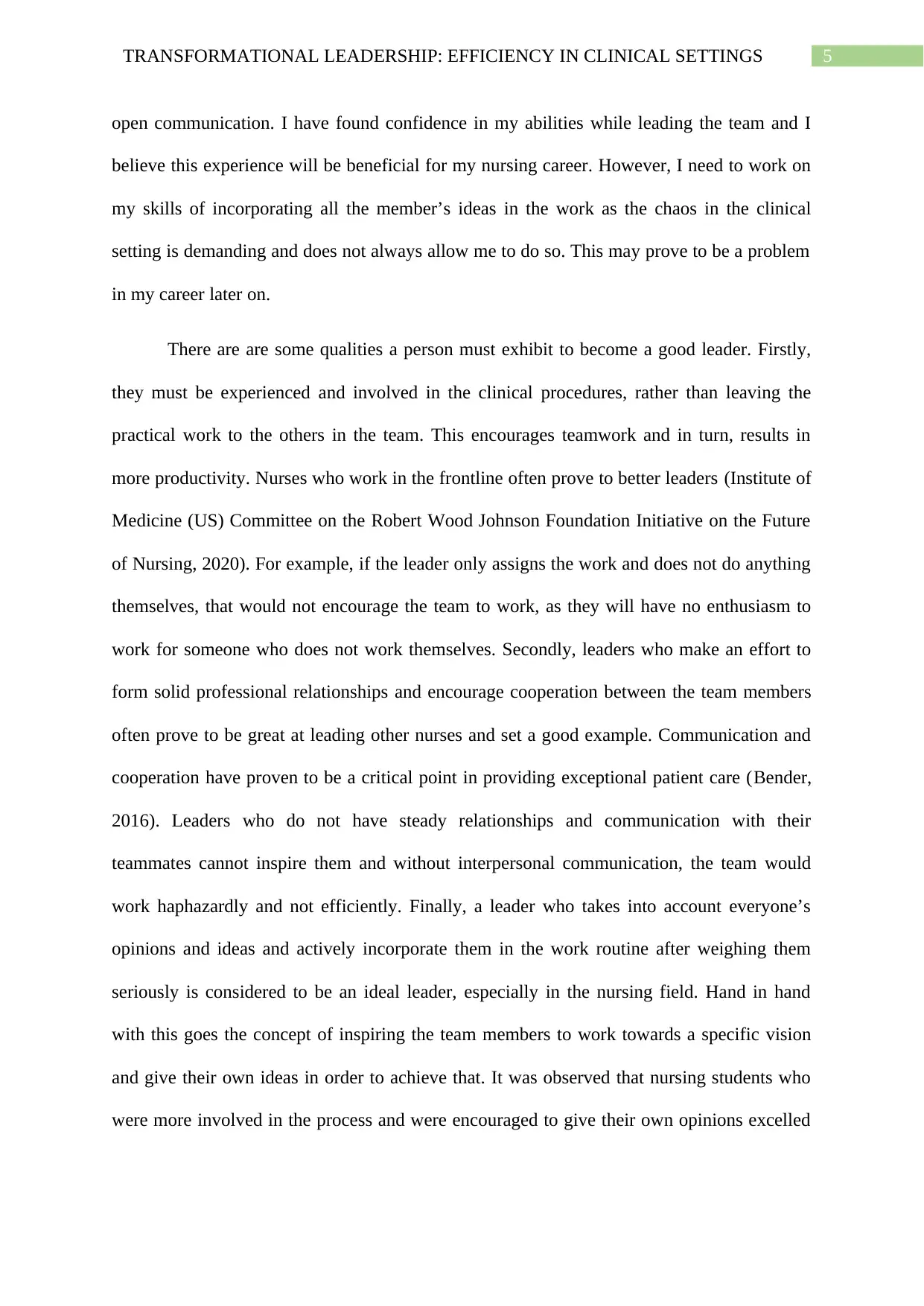
5TRANSFORMATIONAL LEADERSHIP: EFFICIENCY IN CLINICAL SETTINGS
open communication. I have found confidence in my abilities while leading the team and I
believe this experience will be beneficial for my nursing career. However, I need to work on
my skills of incorporating all the member’s ideas in the work as the chaos in the clinical
setting is demanding and does not always allow me to do so. This may prove to be a problem
in my career later on.
There are are some qualities a person must exhibit to become a good leader. Firstly,
they must be experienced and involved in the clinical procedures, rather than leaving the
practical work to the others in the team. This encourages teamwork and in turn, results in
more productivity. Nurses who work in the frontline often prove to better leaders (Institute of
Medicine (US) Committee on the Robert Wood Johnson Foundation Initiative on the Future
of Nursing, 2020). For example, if the leader only assigns the work and does not do anything
themselves, that would not encourage the team to work, as they will have no enthusiasm to
work for someone who does not work themselves. Secondly, leaders who make an effort to
form solid professional relationships and encourage cooperation between the team members
often prove to be great at leading other nurses and set a good example. Communication and
cooperation have proven to be a critical point in providing exceptional patient care (Bender,
2016). Leaders who do not have steady relationships and communication with their
teammates cannot inspire them and without interpersonal communication, the team would
work haphazardly and not efficiently. Finally, a leader who takes into account everyone’s
opinions and ideas and actively incorporate them in the work routine after weighing them
seriously is considered to be an ideal leader, especially in the nursing field. Hand in hand
with this goes the concept of inspiring the team members to work towards a specific vision
and give their own ideas in order to achieve that. It was observed that nursing students who
were more involved in the process and were encouraged to give their own opinions excelled
open communication. I have found confidence in my abilities while leading the team and I
believe this experience will be beneficial for my nursing career. However, I need to work on
my skills of incorporating all the member’s ideas in the work as the chaos in the clinical
setting is demanding and does not always allow me to do so. This may prove to be a problem
in my career later on.
There are are some qualities a person must exhibit to become a good leader. Firstly,
they must be experienced and involved in the clinical procedures, rather than leaving the
practical work to the others in the team. This encourages teamwork and in turn, results in
more productivity. Nurses who work in the frontline often prove to better leaders (Institute of
Medicine (US) Committee on the Robert Wood Johnson Foundation Initiative on the Future
of Nursing, 2020). For example, if the leader only assigns the work and does not do anything
themselves, that would not encourage the team to work, as they will have no enthusiasm to
work for someone who does not work themselves. Secondly, leaders who make an effort to
form solid professional relationships and encourage cooperation between the team members
often prove to be great at leading other nurses and set a good example. Communication and
cooperation have proven to be a critical point in providing exceptional patient care (Bender,
2016). Leaders who do not have steady relationships and communication with their
teammates cannot inspire them and without interpersonal communication, the team would
work haphazardly and not efficiently. Finally, a leader who takes into account everyone’s
opinions and ideas and actively incorporate them in the work routine after weighing them
seriously is considered to be an ideal leader, especially in the nursing field. Hand in hand
with this goes the concept of inspiring the team members to work towards a specific vision
and give their own ideas in order to achieve that. It was observed that nursing students who
were more involved in the process and were encouraged to give their own opinions excelled
⊘ This is a preview!⊘
Do you want full access?
Subscribe today to unlock all pages.

Trusted by 1+ million students worldwide
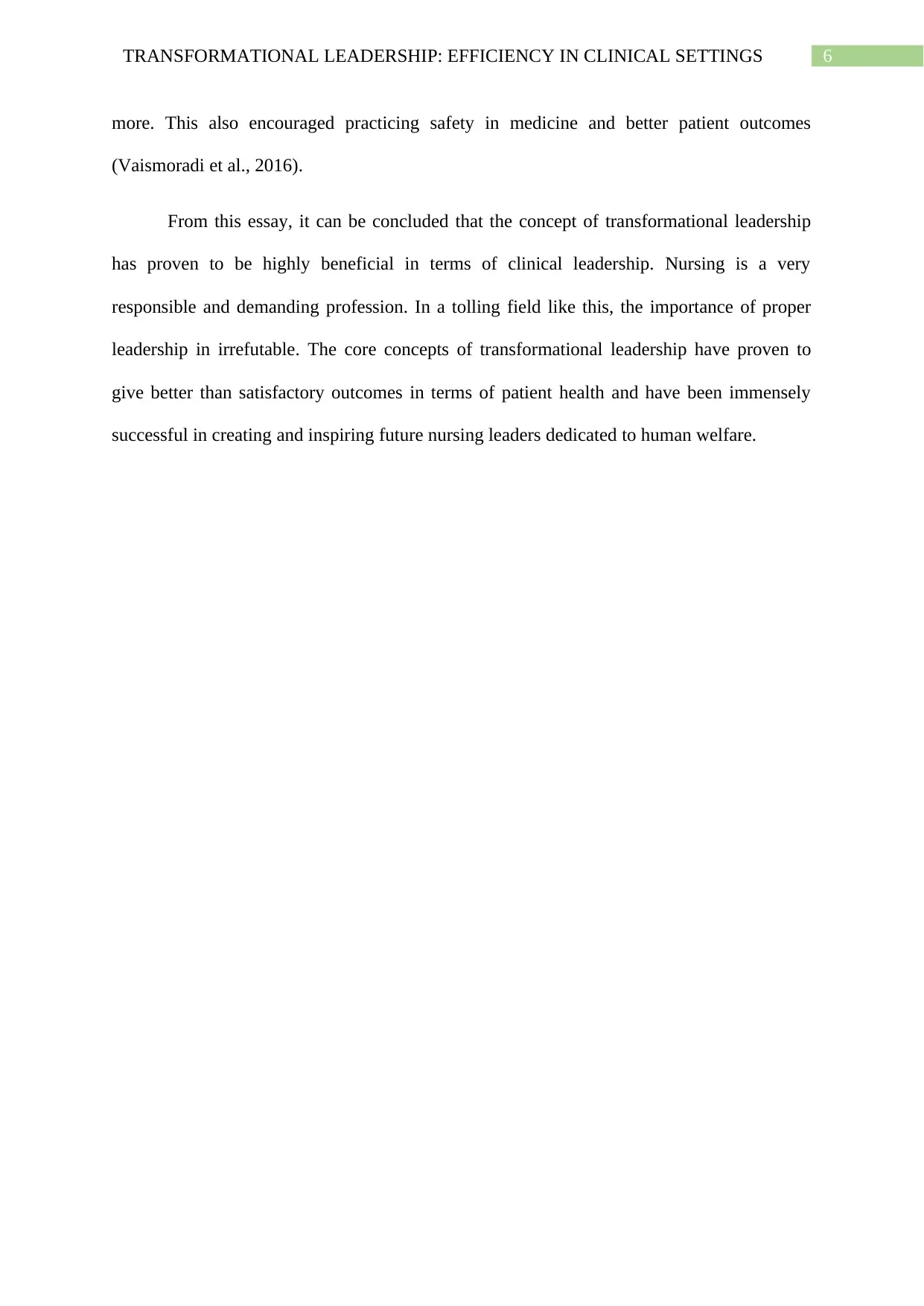
6TRANSFORMATIONAL LEADERSHIP: EFFICIENCY IN CLINICAL SETTINGS
more. This also encouraged practicing safety in medicine and better patient outcomes
(Vaismoradi et al., 2016).
From this essay, it can be concluded that the concept of transformational leadership
has proven to be highly beneficial in terms of clinical leadership. Nursing is a very
responsible and demanding profession. In a tolling field like this, the importance of proper
leadership in irrefutable. The core concepts of transformational leadership have proven to
give better than satisfactory outcomes in terms of patient health and have been immensely
successful in creating and inspiring future nursing leaders dedicated to human welfare.
more. This also encouraged practicing safety in medicine and better patient outcomes
(Vaismoradi et al., 2016).
From this essay, it can be concluded that the concept of transformational leadership
has proven to be highly beneficial in terms of clinical leadership. Nursing is a very
responsible and demanding profession. In a tolling field like this, the importance of proper
leadership in irrefutable. The core concepts of transformational leadership have proven to
give better than satisfactory outcomes in terms of patient health and have been immensely
successful in creating and inspiring future nursing leaders dedicated to human welfare.
Paraphrase This Document
Need a fresh take? Get an instant paraphrase of this document with our AI Paraphraser
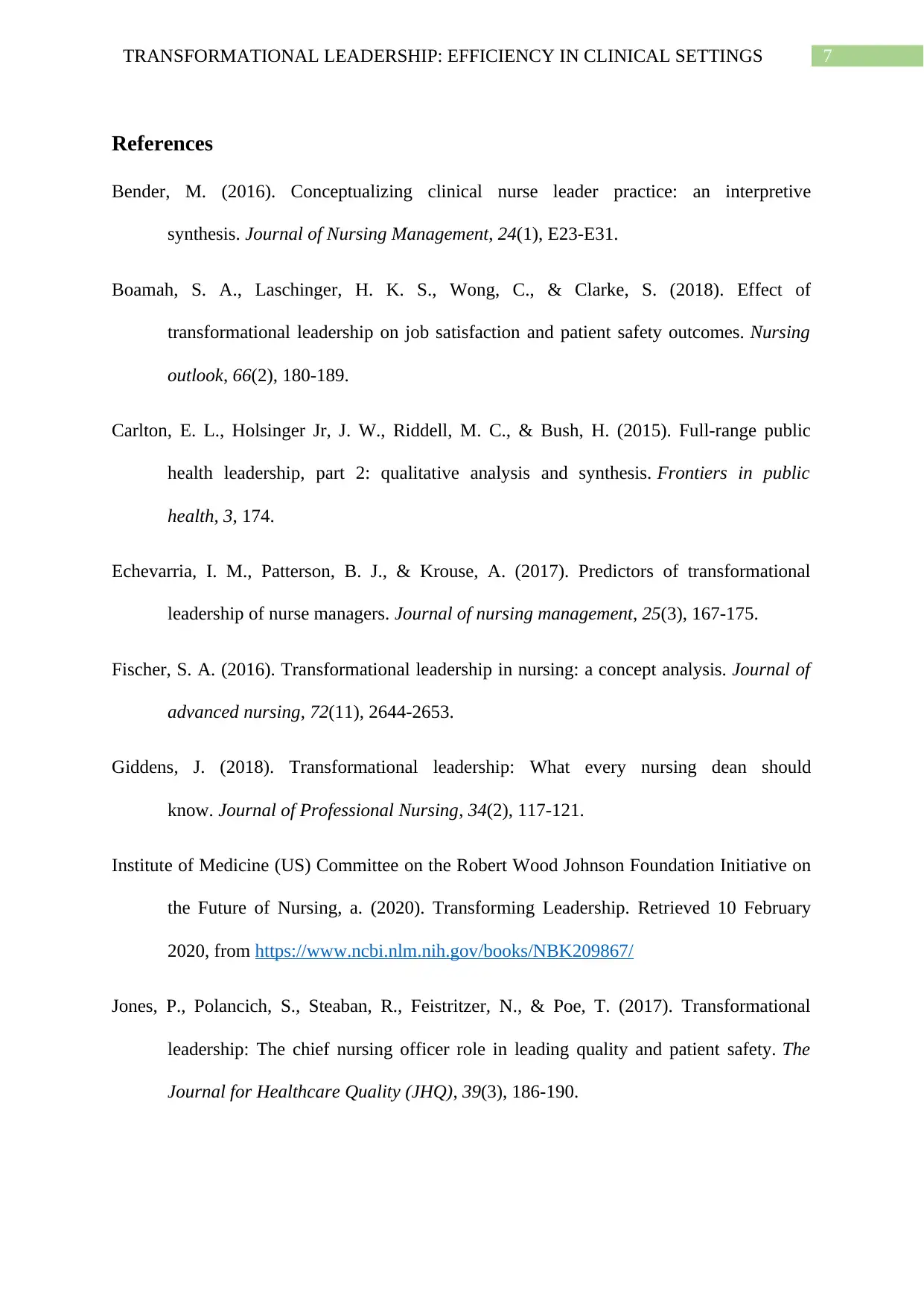
7TRANSFORMATIONAL LEADERSHIP: EFFICIENCY IN CLINICAL SETTINGS
References
Bender, M. (2016). Conceptualizing clinical nurse leader practice: an interpretive
synthesis. Journal of Nursing Management, 24(1), E23-E31.
Boamah, S. A., Laschinger, H. K. S., Wong, C., & Clarke, S. (2018). Effect of
transformational leadership on job satisfaction and patient safety outcomes. Nursing
outlook, 66(2), 180-189.
Carlton, E. L., Holsinger Jr, J. W., Riddell, M. C., & Bush, H. (2015). Full-range public
health leadership, part 2: qualitative analysis and synthesis. Frontiers in public
health, 3, 174.
Echevarria, I. M., Patterson, B. J., & Krouse, A. (2017). Predictors of transformational
leadership of nurse managers. Journal of nursing management, 25(3), 167-175.
Fischer, S. A. (2016). Transformational leadership in nursing: a concept analysis. Journal of
advanced nursing, 72(11), 2644-2653.
Giddens, J. (2018). Transformational leadership: What every nursing dean should
know. Journal of Professional Nursing, 34(2), 117-121.
Institute of Medicine (US) Committee on the Robert Wood Johnson Foundation Initiative on
the Future of Nursing, a. (2020). Transforming Leadership. Retrieved 10 February
2020, from https://www.ncbi.nlm.nih.gov/books/NBK209867/
Jones, P., Polancich, S., Steaban, R., Feistritzer, N., & Poe, T. (2017). Transformational
leadership: The chief nursing officer role in leading quality and patient safety. The
Journal for Healthcare Quality (JHQ), 39(3), 186-190.
References
Bender, M. (2016). Conceptualizing clinical nurse leader practice: an interpretive
synthesis. Journal of Nursing Management, 24(1), E23-E31.
Boamah, S. A., Laschinger, H. K. S., Wong, C., & Clarke, S. (2018). Effect of
transformational leadership on job satisfaction and patient safety outcomes. Nursing
outlook, 66(2), 180-189.
Carlton, E. L., Holsinger Jr, J. W., Riddell, M. C., & Bush, H. (2015). Full-range public
health leadership, part 2: qualitative analysis and synthesis. Frontiers in public
health, 3, 174.
Echevarria, I. M., Patterson, B. J., & Krouse, A. (2017). Predictors of transformational
leadership of nurse managers. Journal of nursing management, 25(3), 167-175.
Fischer, S. A. (2016). Transformational leadership in nursing: a concept analysis. Journal of
advanced nursing, 72(11), 2644-2653.
Giddens, J. (2018). Transformational leadership: What every nursing dean should
know. Journal of Professional Nursing, 34(2), 117-121.
Institute of Medicine (US) Committee on the Robert Wood Johnson Foundation Initiative on
the Future of Nursing, a. (2020). Transforming Leadership. Retrieved 10 February
2020, from https://www.ncbi.nlm.nih.gov/books/NBK209867/
Jones, P., Polancich, S., Steaban, R., Feistritzer, N., & Poe, T. (2017). Transformational
leadership: The chief nursing officer role in leading quality and patient safety. The
Journal for Healthcare Quality (JHQ), 39(3), 186-190.
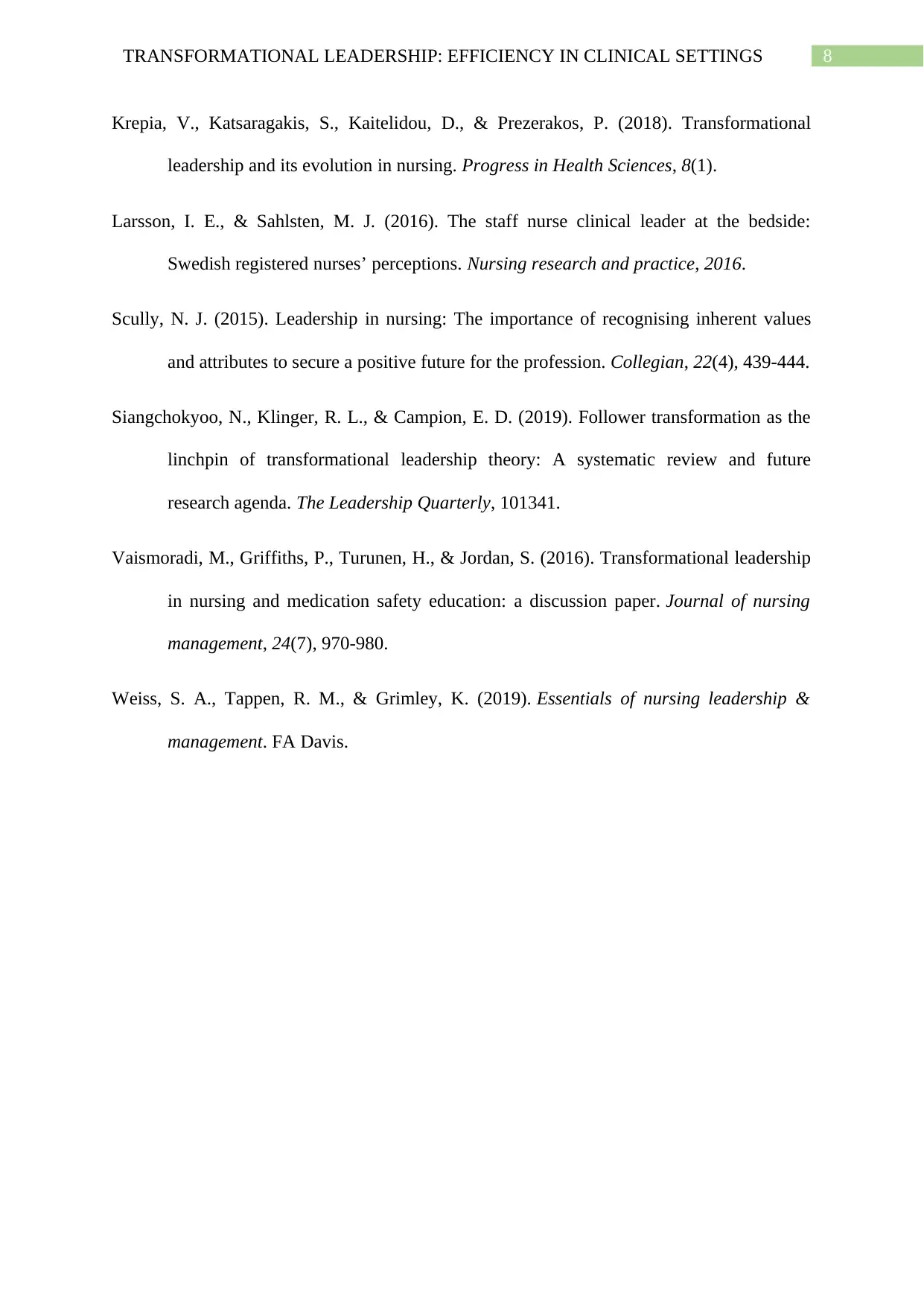
8TRANSFORMATIONAL LEADERSHIP: EFFICIENCY IN CLINICAL SETTINGS
Krepia, V., Katsaragakis, S., Kaitelidou, D., & Prezerakos, P. (2018). Transformational
leadership and its evolution in nursing. Progress in Health Sciences, 8(1).
Larsson, I. E., & Sahlsten, M. J. (2016). The staff nurse clinical leader at the bedside:
Swedish registered nurses’ perceptions. Nursing research and practice, 2016.
Scully, N. J. (2015). Leadership in nursing: The importance of recognising inherent values
and attributes to secure a positive future for the profession. Collegian, 22(4), 439-444.
Siangchokyoo, N., Klinger, R. L., & Campion, E. D. (2019). Follower transformation as the
linchpin of transformational leadership theory: A systematic review and future
research agenda. The Leadership Quarterly, 101341.
Vaismoradi, M., Griffiths, P., Turunen, H., & Jordan, S. (2016). Transformational leadership
in nursing and medication safety education: a discussion paper. Journal of nursing
management, 24(7), 970-980.
Weiss, S. A., Tappen, R. M., & Grimley, K. (2019). Essentials of nursing leadership &
management. FA Davis.
Krepia, V., Katsaragakis, S., Kaitelidou, D., & Prezerakos, P. (2018). Transformational
leadership and its evolution in nursing. Progress in Health Sciences, 8(1).
Larsson, I. E., & Sahlsten, M. J. (2016). The staff nurse clinical leader at the bedside:
Swedish registered nurses’ perceptions. Nursing research and practice, 2016.
Scully, N. J. (2015). Leadership in nursing: The importance of recognising inherent values
and attributes to secure a positive future for the profession. Collegian, 22(4), 439-444.
Siangchokyoo, N., Klinger, R. L., & Campion, E. D. (2019). Follower transformation as the
linchpin of transformational leadership theory: A systematic review and future
research agenda. The Leadership Quarterly, 101341.
Vaismoradi, M., Griffiths, P., Turunen, H., & Jordan, S. (2016). Transformational leadership
in nursing and medication safety education: a discussion paper. Journal of nursing
management, 24(7), 970-980.
Weiss, S. A., Tappen, R. M., & Grimley, K. (2019). Essentials of nursing leadership &
management. FA Davis.
⊘ This is a preview!⊘
Do you want full access?
Subscribe today to unlock all pages.

Trusted by 1+ million students worldwide
1 out of 9
Related Documents
Your All-in-One AI-Powered Toolkit for Academic Success.
+13062052269
info@desklib.com
Available 24*7 on WhatsApp / Email
![[object Object]](/_next/static/media/star-bottom.7253800d.svg)
Unlock your academic potential
Copyright © 2020–2025 A2Z Services. All Rights Reserved. Developed and managed by ZUCOL.





